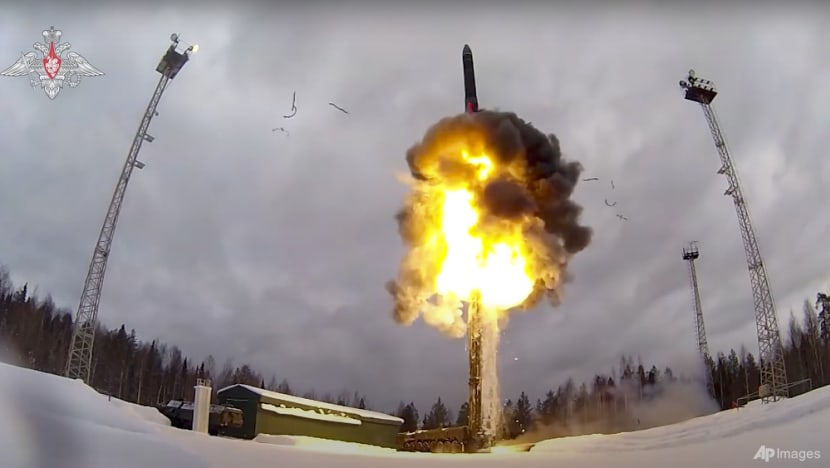Not many treaties can restrict Russia if it decides to use nuclear weapons: Analyst

FILE - This photo taken from video provided by the Russian Defense Ministry Press Service on Feb. 19, 2022, shows a Yars intercontinental ballistic missile being launched from an air field during military drills. (Russian Defense Ministry Press Service via AP)
SINGAPORE: Not many treaties can govern or restrict Russia if President Vladimir Putin decides to make good on his threat to use nuclear weapons in its war in Ukraine, said an analyst.
“The only thing that really keeps (Russia) from doing that is that there has been a norm of non-use since the US used nuclear weapons against Hiroshima and Nagasaki in World War II,” research professor Sharon Ann Squassoni told CNA’s Asia First on Monday (Sep 26).
“But ultimately, there really aren’t many treaties that could govern or that would restrict Russia from using nuclear weapons,” said Prof Squassoni of the Elliott School of International Affairs at George Washington University.
“Ultimately, it's going to rest in President Putin's hands. And that's the scary thing.”
Mr Putin made a thinly veiled nuclear threat last week as he ordered a partial mobilisation of 300,000 reservists, and said that Russia would “use all the means at our disposal” to defend its territory.
Russia is planning to annex the regions of Luhansk, Donetsk, Zaporizhzhia and Kherson through ongoing self-style referendums, and analysts see the move as a way for Moscow to claim them as Russian sovereign territory, effectively warning Ukraine that they risk retaliation – even nuclear weapons – if Kyiv tries to retake them.
The New START treaty, an arms control agreement between Russia and US that will last until 2026, places verifiable limits on all deployed intercontinental-range nuclear weapons, but Russia has suspended the inspections of its weapons.
There are also no current agreements between the two countries on regulating the number or the deployment of intermediate-range nuclear weapons. Short-range nuclear weapons are also not subject to any legal restraints, independent policy institute Chatham House said in an explainer.
The think tank said that if Russia were to use nuclear weapons, it will likely do so within Ukraine, which is not a North Atlantic Treaty Organization (NATO) member, and less likely on NATO or US cities, as that can prompt a similar response on Russian soil.
RUSSIA AND US HAVE MAJORITY OF WORLD’S NUKES
Nine countries today are armed with atomic bombs that are on average 20 to 30 times stronger than those dropped in World War II.
Russia and US together have about 90 per cent of the world’s nuclear weapons, with more than 5,500 each, according to the International Campaign to Abolish Nuclear Weapons (ICAN).
The B-83 nuclear bomb, with about 650 in active service, is the highest yield nuclear weapon in US’ arsenal – 80 times more powerful than Little Boy, the bomb that dropped on Hiroshima in 1945 which killed an estimated 66,000 people, with tens of thousands more dying later from radiation exposure.
Russia's Tsar Bomba, a hydrogen aerial bomb produced during the Soviet era and detonated in 1961, is the most powerful nuclear weapon ever created – with a destructive force 3,333 times that of Little Boy.
The two countries’ vast arsenals of active nuclear weapons is an “overkill”, and enough to obliterate each other’s cities eight times over, atmospheric and oceanic sciences professor Owen Brian Toon told CNA’s Asia First.
“Russia and America have about 2,000 (nuclear weapons each) that are deployed and can potentially be fired very quickly. But even a small number of these weapons is incredibly dangerous,” explained Prof Toon of University of Colorado Boulder’s laboratory for atmospheric and space physics.
“Russia only has 200 cities with 100,000 people. The US only has 300 cities with more than 100,000 people. So with these 2,000 weapons, US and Russia could attack each city with about eight nuclear weapons,” said Prof Toon. “This is ridiculous because one nuclear weapon is enough to destroy a city. So there's a vast amount of overkill in these weapons.”
THE POTENTIAL EFFECTS OF A NUCLEAR WAR
A “nuclear winter” – weather calamities scientists believe would result from dust clouds blocking out sunlight – which in theory could be caused by the sheer scale of a nuclear war between Russia and NATO, can wipe out about 80 per cent of the global population, said Prof Toon.
“Of about 6 billion people that we have assumed in this model, 5 billion would die within the second year. And things would continue to be bad for several more years,” Prof Toon said of a hypothetical nuclear war between Russia and NATO, and its effect globally.
The damage from a nuclear blast is not contained to just ground zero and radiation, but will have far-reaching effects stemming from environmental catastrophes triggered by the detonation, said Prof Toon.
“A nuclear explosion is a bright burst of light. It's like bringing a piece of the sun down to the ground, and that bright burst of light can start everything on fire,” cautioned Prof Toon. Apart from primary fires from the heat radiated by the explosion, secondary fires can be caused by anything from collapsed buildings to damaged electrical systems.
Large amounts of smoke generated by fires from the blasts would rise into the upper atmosphere and into the stratosphere, where a lack of rain would cause the smoke to take more time to dissipate. Smoke in the stratosphere would absorb sunlight and prevent it from reaching the lower atmosphere, where we live.
The scale of a nuclear war between Russia and NATO will likely reduce the sunlight from reaching the ground by about 80 per cent, causing ground temperatures to plummet by up to 25 degrees Celsius, said Prof Toon.
As a consequence, there would be rapid cooling of the earth’s surface, causing mid-latitudes areas such as Ukraine or Iowa in the US, to reach freezing temperatures within a few weeks, eliminating agriculture.
Countries with higher latitudes, especially those in or near the conflict, will see a larger number of casualties due to colder climates and shorter agricultural seasons, but the spillover effects will be felt far and wide, with adverse weather conditions and a global food crisis.
“An important assumption in here is that transport stops. As whatever people find to grow they keep because their populations are starving,” said Prof Toon. “
Countries like Singapore which don’t grow much food will suffer, he added.
“Probably no one would send any food to Singapore in a situation like this. They would keep it for themselves,” he said.
“NO COUNTRY’S INNOCENT HERE”
Countries that are still catching up in the nuclear race, such as China, are unlikely to stop their progress as long as big players like the US and Russia refuse to denuclearise, said Prof Squassoni.
“The real concern right now is that China is moving away from what we call a ‘minimal credible deterrent’, which is low numbers of weapons. China has about 350 nuclear weapons against thousands. So, there's no country that's innocent here,” said Prof Squassoni.
“There's a myth about nuclear weapons, which is that they prevent conventional war. But that is certainly not the case.”
International efforts for nuclear disarmament have seen little support from nuclear powers, said Prof Squassoni. In January, the UN’s Treaty on the Prohibition of Nuclear Weapons (TPNW), a binding global agreement to prohibit nuclear weapons and advocate peaceful uses of nuclear energy, came into force but was not signed by any nuclear-armed country, including Russia and the US.
“When countries have nuclear weapons, they start to think about and plan for scenarios where they might be used,” said Prof Squassoni. “The (TPNW treaty that came into force) - none of the countries with nuclear weapons participated in the negotiations, or even observed them. So we need to get back on a diplomatic track."















